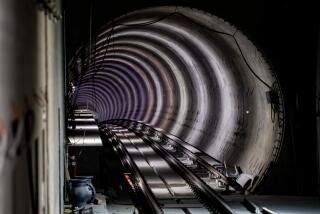New Hope for North Hollywood
Two development projects under consideration for the desolate heart of North Hollywood offer hope in an otherwise gridlocked future. Two developers are competing to work with the Community Redevelopment Agency to build massive studio and office complexes adjacent to the Red Line subway station expected to open in 2001 on Lankershim Boulevard.
Between them, the two projects envision intense development of office towers, hotels, apartments, restaurants and working studios. They are precisely the sort of traffic-heavy uses that overload surrounding streets and freeways. And they are precisely the sort of projects that ought to be built atop and around subway stations.
At $300 million a mile, the Red Line subway project represents one of the biggest infrastructure investments ever made in Los Angeles. Yet planners and other local officials have been slow to capitalize on its potential to reshape the city and the region. Just as the Pacific Electric Railway drew the boundaries of the modern metropolis, the Red Line holds the potential to reinvigorate neighborhoods hosting stations. Even with last week’s passage of a measure blocking future subway construction, the system could be exploited.
Transit-oriented development has long been a central tenet of the Metropolitan Transportation Authority’s long-term plans. The General Plan for Los Angeles encourages more development around stations to create neighborhoods where it’s easier to walk and use public transportation. That’s smart. Transportation planners forecast that average speeds on some San Fernando Valley freeways could drop below 10 mph as population and traffic increases.
The theory behind transit-oriented development is simple: Creating a chain of dense neighborhoods allows residents to move from district to district without ever using a car. Plus, channeling new development into these districts relieves the pressure on residential neighborhoods and community commercial strips. Those would be protected from intrusive development as new high-density districts sprout every few miles along the subway route.
The concept has already been put in place in West Coast cities from San Francisco to Seattle. In Southern California, the implementation has been spotty.
Some Metrolink stations offer services such as day-care and snacks to harried commuters. Plans include dry cleaners and grocery stores to cut down on the number of car trips passengers take after leaving the train. But the two North Hollywood projects--Academy Media Center and North Hollywood Studio Complex--would be the largest to put this simple concept into practice. Backers claim employees and residents of the projects could hop on a subway and be in Hollywood in 10 minutes and all the way downtown in about 20. Meantime, either project would be a boost to a neighborhood that has known little but tough times over the past 30 years.
Some residents and shopkeepers are wary of the CRA and its power to condemn property for public use. The Times shares their concerns, particularly if viable businesses are shuttered to make way for a grand design that may never materialize. Both developers maintain that their plans include provisions for existing businesses. These are the sorts of projects critical to reviving not only North Hollywood, but wide sections of the city. They should proceed. But zeal for the future should not overlook the shopkeepers and residents who deserve to share in any revival.
More to Read
Sign up for Essential California
The most important California stories and recommendations in your inbox every morning.
You may occasionally receive promotional content from the Los Angeles Times.










